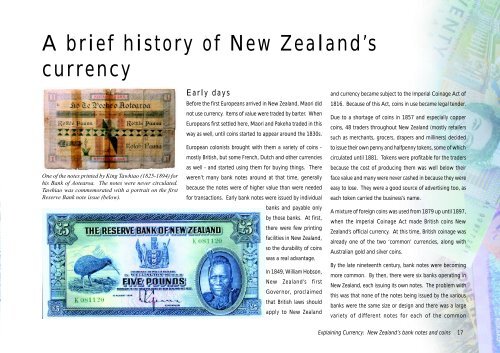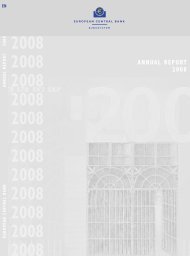Explaining Currency: New Zealand's bank notes and coins
Explaining Currency: New Zealand's bank notes and coins
Explaining Currency: New Zealand's bank notes and coins
You also want an ePaper? Increase the reach of your titles
YUMPU automatically turns print PDFs into web optimized ePapers that Google loves.
A brief history of <strong>New</strong> Zeal<strong>and</strong>’scurrencyOne of the <strong>notes</strong> printed by King Tawhiao (1825-1894) forhis Bank of Aotearoa. The <strong>notes</strong> were never circulated.Tawhiao was commemorated with a portrait on the firstReserve Bank note issue (below).Early daysBefore the first Europeans arrived in <strong>New</strong> Zeal<strong>and</strong>, Maori didnot use currency. Items of value were traded by barter. WhenEuropeans first settled here, Maori <strong>and</strong> Pakeha traded in thisway as well, until <strong>coins</strong> started to appear around the 1830s.European colonists brought with them a variety of <strong>coins</strong> -mostly British, but some French, Dutch <strong>and</strong> other currenciesas well - <strong>and</strong> started using them for buying things. Thereweren’t many <strong>bank</strong> <strong>notes</strong> around at that time, generallybecause the <strong>notes</strong> were of higher value than were neededfor transactions. Early <strong>bank</strong> <strong>notes</strong> were issued by individual<strong>bank</strong>s <strong>and</strong> payable onlyby those <strong>bank</strong>s. At first,there were few printingfacilities in <strong>New</strong> Zeal<strong>and</strong>,so the durability of <strong>coins</strong>was a real advantage.In 1849, William Hobson,<strong>New</strong> Zeal<strong>and</strong>’s firstGovernor, proclaimedthat British laws shouldapply to <strong>New</strong> Zeal<strong>and</strong><strong>and</strong> currency became subject to the Imperial Coinage Act of1816. Because of this Act, <strong>coins</strong> in use became legal tender.Due to a shortage of <strong>coins</strong> in 1857 <strong>and</strong> especially copper<strong>coins</strong>, 48 traders throughout <strong>New</strong> Zeal<strong>and</strong> (mostly retailerssuch as merchants, grocers, drapers <strong>and</strong> milliners) decidedto issue their own penny <strong>and</strong> halfpenny tokens, some of whichcirculated until 1881. Tokens were profitable for the tradersbecause the cost of producing them was well below theirface value <strong>and</strong> many were never cashed in because they wereeasy to lose. They were a good source of advertising too, aseach token carried the business’s name.A mixture of foreign <strong>coins</strong> was used from 1879 up until 1897,when the Imperial Coinage Act made British <strong>coins</strong> <strong>New</strong>Zeal<strong>and</strong>’s official currency. At this time, British coinage wasalready one of the two ‘common’ currencies, along withAustralian gold <strong>and</strong> silver <strong>coins</strong>.By the late nineteenth century, <strong>bank</strong> <strong>notes</strong> were becomingmore common. By then, there were six <strong>bank</strong>s operating in<strong>New</strong> Zeal<strong>and</strong>, each issuing its own <strong>notes</strong>. The problem withthis was that none of the <strong>notes</strong> being issued by the various<strong>bank</strong>s were the same size or design <strong>and</strong> there was a largevariety of different <strong>notes</strong> for each of the common<strong>Explaining</strong> <strong>Currency</strong>: <strong>New</strong> Zeal<strong>and</strong>’s <strong>bank</strong> <strong>notes</strong> <strong>and</strong> <strong>coins</strong> 17





![KNOW YOUR NEW GIBRALTAR BANKNOTES - [Home] bThe/b](https://img.yumpu.com/50890985/1/184x260/know-your-new-gibraltar-banknotes-home-bthe-b.jpg?quality=85)
![PAPUA NEW GUINEA - [Home] - Polymer Bank Notes of the World](https://img.yumpu.com/49758743/1/190x143/papua-new-guinea-home-polymer-bank-notes-of-the-world.jpg?quality=85)









